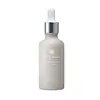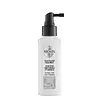What's inside
What's inside
 Key Ingredients
Key Ingredients

 Benefits
Benefits

 Concerns
Concerns

 Ingredients Side-by-side
Ingredients Side-by-side

Water
Skin ConditioningAlcohol Denat.
AntimicrobialButylene Glycol
HumectantPEG-30 Hydrogenated Castor Oil
EmulsifyingPanthenol
Skin ConditioningSwertia Japonica Extract
Skin ConditioningMorus Alba Extract
AstringentHoney
HumectantOryza Sativa Lees Extract
Skin ConditioningMelaleuca Alternifolia Leaf Extract
PerfumingSaccharomyces/Rice Ferment Filtrate
Skin ConditioningPropanediol
SolventAnthemis Nobilis Flower Extract
MaskingTocopherol
AntioxidantHydrolyzed Corn Starch
HumectantSodium Dilauramidoglutamide Lysine
HumectantDipotassium Glycyrrhizate
HumectantSqualane
EmollientMenthol
MaskingCarbomer
Emulsion StabilisingParfum
MaskingDisodium EDTA
Benzyl Alcohol
PerfumingPhenoxyethanol
PreservativePotassium Hydroxide
BufferingWater, Alcohol Denat., Butylene Glycol, PEG-30 Hydrogenated Castor Oil, Panthenol, Swertia Japonica Extract, Morus Alba Extract, Honey, Oryza Sativa Lees Extract, Melaleuca Alternifolia Leaf Extract, Saccharomyces/Rice Ferment Filtrate, Propanediol, Anthemis Nobilis Flower Extract, Tocopherol, Hydrolyzed Corn Starch, Sodium Dilauramidoglutamide Lysine, Dipotassium Glycyrrhizate, Squalane, Menthol, Carbomer, Parfum, Disodium EDTA, Benzyl Alcohol, Phenoxyethanol, Potassium Hydroxide
Water
Skin ConditioningNiacinamide
SmoothingCaffeine
Skin ConditioningPhenoxyethanol
PreservativeSodium Benzoate
MaskingBenzyl Alcohol
PerfumingAcrylates/C10-30 Alkyl Acrylate Crosspolymer
Emulsion StabilisingPolysorbate 80
EmulsifyingPolysorbate 60
EmulsifyingAcetamide Mea
HumectantTriethanolamine
BufferingPEG-23m
Emulsion StabilisingPropylene Glycol
HumectantTetrasodium EDTA
Methyl Nicotinate
SoothingParfum
MaskingMentha Arvensis Leaf Oil
MaskingMentha Piperita Oil
MaskingPEG-30 Dipolyhydroxystearate
EmulsifyingTrideceth-6
EmulsifyingLimonene
PerfumingCamellia Sinensis Leaf Extract
AntimicrobialSilica
AbrasiveCystine Bis-Pg-Propyl Silanetriol
Skin ConditioningBiotin
AntiseborrhoeicLecithin
EmollientTocopheryl Acetate
AntioxidantHumulus Lupulus Extract
AntimicrobialCitrus Paradisi Peel Extract
PerfumingUrtica Dioica Leaf Extract
Skin ConditioningAcer Saccharum Extract
Skin ConditioningCitrus Limon Peel Extract
EmollientSaccharum Officinarum Extract
MoisturisingVaccinium Myrtillus Leaf Extract
AstringentFaex Extract
Skin ConditioningPropylparaben
PreservativeCitrus Aurantium Dulcis Fruit Extract
MaskingBHT
AntioxidantPotassium Sorbate
PreservativeMaltodextrin
AbsorbentMethylparaben
PreservativeEthylparaben
PreservativeButylparaben
MaskingWater, Niacinamide, Caffeine, Phenoxyethanol, Sodium Benzoate, Benzyl Alcohol, Acrylates/C10-30 Alkyl Acrylate Crosspolymer, Polysorbate 80, Polysorbate 60, Acetamide Mea, Triethanolamine, PEG-23m, Propylene Glycol, Tetrasodium EDTA, Methyl Nicotinate, Parfum, Mentha Arvensis Leaf Oil, Mentha Piperita Oil, PEG-30 Dipolyhydroxystearate, Trideceth-6, Limonene, Camellia Sinensis Leaf Extract, Silica, Cystine Bis-Pg-Propyl Silanetriol, Biotin, Lecithin, Tocopheryl Acetate, Humulus Lupulus Extract, Citrus Paradisi Peel Extract, Urtica Dioica Leaf Extract, Acer Saccharum Extract, Citrus Limon Peel Extract, Saccharum Officinarum Extract, Vaccinium Myrtillus Leaf Extract, Faex Extract, Propylparaben, Citrus Aurantium Dulcis Fruit Extract, BHT, Potassium Sorbate, Maltodextrin, Methylparaben, Ethylparaben, Butylparaben
Ingredients Explained
These ingredients are found in both products.
Ingredients higher up in an ingredient list are typically present in a larger amount.
Benzyl Alcohol is most commonly used as a preservative. It also has a subtle, sweet smell. Small amounts of Benzyl Alcohol is not irritating and safe to use in skincare products. Most Benzyl Alcohol is derived from fruits such as apricots.
Benzyl Alcohol has both antibacterial and antioxidant properties. These properties help lengthen the shelf life of products. Benzyl Alcohol is a solvent and helps dissolve other ingredients. It can also improve the texture and spreadability.
Alcohol comes in many different forms. Different types of alcohol will have different effects on skin. This ingredient is an astringent alcohol.
Using high concentrations of these alcohols are drying on the skin. They may strip away your skin's natural oils and even damage your skin barrier. Astringent alcohols may also irritate skin.
Other types of astringent alcohols include:
According to the National Rosacea Society based in the US, you should be mindful of products with these alcohols in the top half of ingredients.
Any type of sanitizing product will have high amounts of alcohol to help kill bacteria and viruses.
Learn more about Benzyl AlcoholParfum is a catch-all term for an ingredient or more that is used to give a scent to products.
Also called "fragrance", this ingredient can be a blend of hundreds of chemicals or plant oils. This means every product with "fragrance" or "parfum" in the ingredients list is a different mixture.
For instance, Habanolide is a proprietary trade name for a specific aroma chemical. When used as a fragrance ingredient in cosmetics, most aroma chemicals fall under the broad labeling category of “FRAGRANCE” or “PARFUM” according to EU and US regulations.
The term 'parfum' or 'fragrance' is not regulated in many countries. In many cases, it is up to the brand to define this term.
For instance, many brands choose to label themselves as "fragrance-free" because they are not using synthetic fragrances. However, their products may still contain ingredients such as essential oils that are considered a fragrance by INCI standards.
One example is Calendula flower extract. Calendula is an essential oil that still imparts a scent or 'fragrance'.
Depending on the blend, the ingredients in the mixture can cause allergies and sensitivities on the skin. Some ingredients that are known EU allergens include linalool and citronellol.
Parfum can also be used to mask or cover an unpleasant scent.
The bottom line is: not all fragrances/parfum/ingredients are created equally. If you are worried about fragrances, we recommend taking a closer look at an ingredient. And of course, we always recommend speaking with a professional.
Learn more about ParfumPhenoxyethanol is a preservative that has germicide, antimicrobial, and aromatic properties. Studies show that phenoxyethanol can prevent microbial growth. By itself, it has a scent that is similar to that of a rose.
It's often used in formulations along with Caprylyl Glycol to preserve the shelf life of products.
Water. It's the most common cosmetic ingredient of all. You'll usually see it at the top of ingredient lists, meaning that it makes up the largest part of the product.
So why is it so popular? Water most often acts as a solvent - this means that it helps dissolve other ingredients into the formulation.
You'll also recognize water as that liquid we all need to stay alive. If you see this, drink a glass of water. Stay hydrated!
Learn more about Water